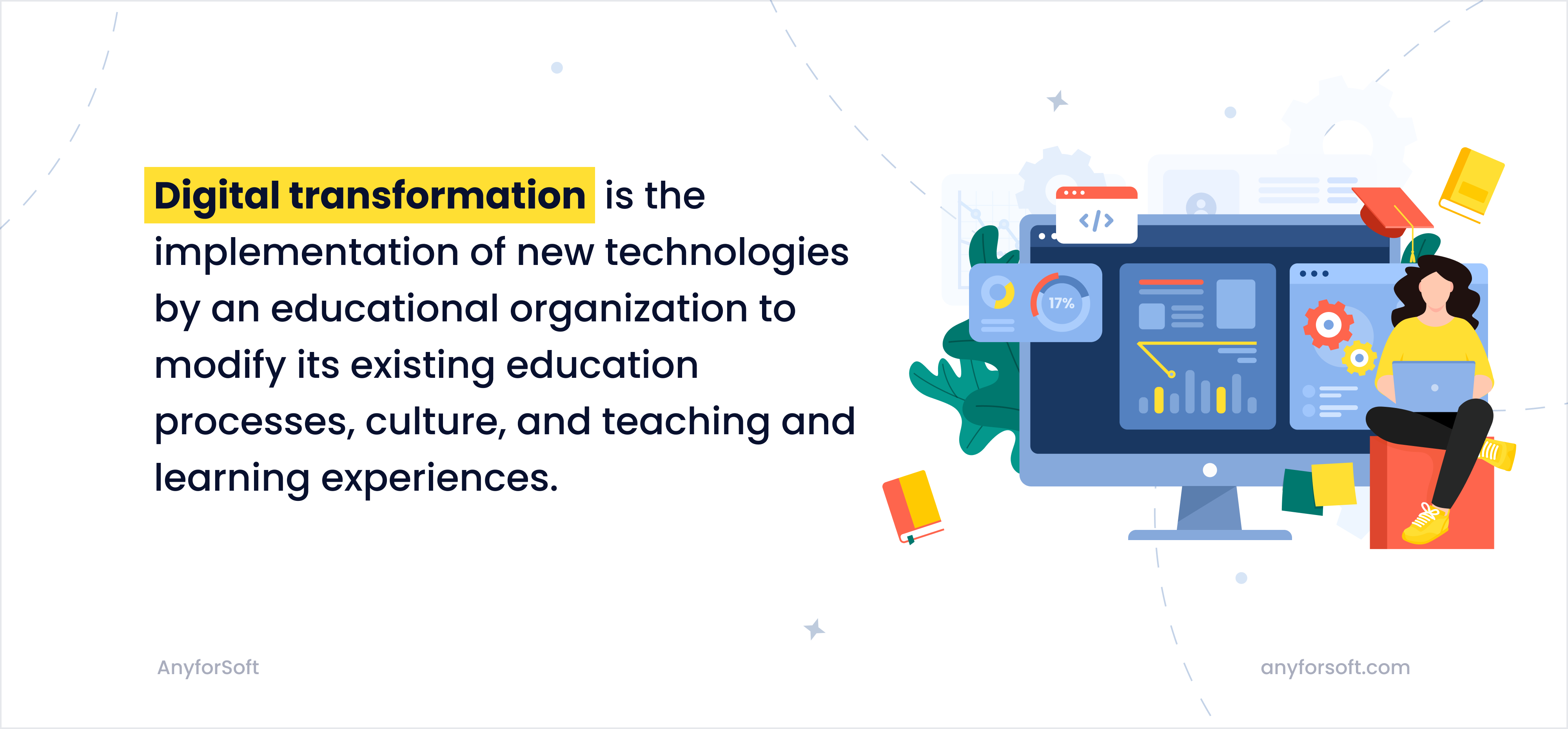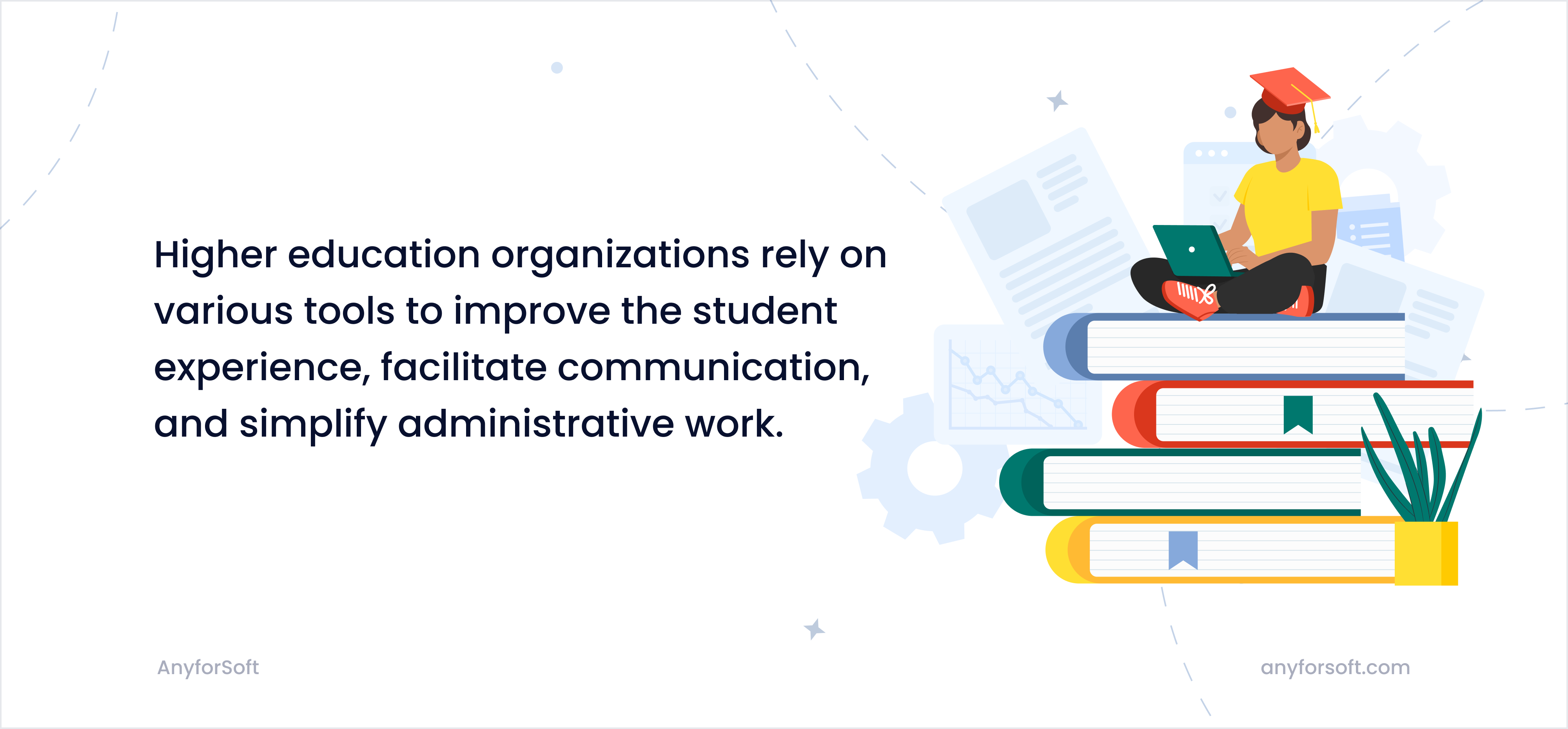Many higher education institutions are reluctant to embrace technology. There are multiple reasons for this:
- Implementing digital initiatives is expensive and time-consuming.
- Higher ed institutions are often run by senior people who are unfamiliar with new technologies and hence don’t understand their importance.
- The government doesn’t allocate the budget to educational institutions for higher education digital transformation.
However, ever since COVID-19 came, things have started to shift.
As you know, schools, community colleges, and universities had to close their doors to prevent the spread of the virus. That made traditional education impossible for a while, forcing educational organizations to switch to remote learning by means of digital technologies.
Even though the pandemic is on the decline now, digital transformation in higher education is still of utmost importance. And if you don’t want to lag behind more tech-savvy organizations and become outdated, you must embrace modern educational technology.
As a company that specializes in education software development services, AnyforSoft couldn’t pass by such a critical topic. We believe that the digital transformation of higher education institutions can benefit the education sector in many ways, and in this article, we’re going to prove our point.
Read further to learn what advantages you can gain from a smart digital strategy.
What is Digital Transformation?

Digital transformation of the higher education sector refers to the implementation of digital solutions by an institution with the goal of modifying existing education processes, culture, and teaching as well as learning experiences. With the help of modern technology, your organization can become more efficient and provide more value to students, professors, and faculty members alike. Keeping up with digital transformation will help your organization operate effectively, stay competitive in the digitalized market, and quickly adapt to future technological advances.
How Digital Transformation Benefits Educational Organizations
Now that we’ve defined the term digital transformation, let’s talk about the benefits that modern technology brings to higher education institutions.
Availability and accessibility
Successful digital transformation will dramatically improve the student experience, allowing your students to study anytime and anywhere. Digital learning doesn’t require learners to be in a specific place and at a specific time to gain knowledge, which removes geographic restrictions and enables students to learn at a comfortable pace. That is especially convenient for people with disabilities or other individuals who can’t visit your institution for some reason.
Simplified administrative tasks
Apart from improving the student experience, digital tools also help handle administrative work more efficiently. As you surely know, such work is tedious and time-consuming when done manually. Learning activity management, student admission processes, attendance tracking—all of these paper-filling tasks require plenty of time and effort that could be spent on something more useful and productive. Modern technologies can simplify and in some cases even automate these tasks, which will free up time for more important activities.
Cost-effectiveness
Running higher education institutions comes with high costs. However, by means of digital technologies, you can make your organization more cost-effective. For example, technology can help you reduce reliance on manual resources; with digital content delivery, you will be able to lower (or completely get rid of) printing costs as well as reliance on printed content. By switching to online courses and materials, you also gain additional flexibility: online content can be quickly updated and distributed, unlike physical books and materials.
Increased student retention
Multiple studies indicate that online learning does a better job of retaining students than traditional learning settings. That happens for a variety of reasons.
First of all, digital learning typically offers a more personalized experience. With the help of artificial intelligence and machine learning, tech-savvy educators offer personalized learning content based on the student’s abilities, interests, past behavior, and other factors. This keeps the learner engaged and motivated, as they feel that the course is designed to meet their specific needs and requirements (which cannot be said about standardized learning courses).
Secondly, the variety of learning resources plays a significant role. By leveraging digital channels, higher education institutions are able to offer educational content in multiple formats, including e-books, videos, presentations, augmented and virtual reality simulations, quizzes, and games (learn more about gamification in e-learning if you’re interested in this topic).
Last but not least, flexibility and convenience also contribute to the increased student retention. When an institution relies on a digital business model, it allows students to learn from the comfort of their homes and at any convenient time. As a result, they don’t feel pressure and can study at a comfortable pace, significantly reducing stress.
Streamlined communication
Phone calls and emails are not very convenient means of communication, as they take too much time.
With modern technology, however, communication can be streamlined and simplified. For example, Southeastern University developed its own parent portal where the staff notifies parents about any important changes and shares academic records, class schedules, student accounts, financial aid awards, and residence information. When any important event takes place, they simply update the information on the portal instead of manually contacting each parent and notifying them. That helps the university’s staff save time and effort.
Examples of Digital Transformation in Higher Education

Now let’s take a look at some examples of educational technology that is used by colleges and universities.
Learning management systems
Learning management systems are heavily adopted by universities worldwide. Most universities in the US, UK, Canada, Australia, and Saudi Arabia rely on various ready-made LMS solutions, including Blackboard, Moodle, Canvas, D2L, and other tools. Some go even further and opt for custom LMS development.
Learning management systems are used by colleges and universities for many reasons:
- Valuable features. LMSs offer plenty of useful features that facilitate education processes, including course management, user management, reports and data analytics, certification, gamification, social learning, personalized learning, and more.
- Organized learning. An LMS platform allows you to keep all of your materials in one place instead of having them scattered across multiple platforms. That facilitates the access for both students and professors.
- Personalized learning. Compared to traditional learning settings, LMSs allow for a personalized learning experience, which increases learner engagement and education effectiveness.
As an LMS development company, AnyforSoft can create a custom learning management system for your educational institution or integrate off-the-shelf software with your system. Learn more about the difference between custom vs. off-the-shelf software.
School management software
School management software helps manage all the educational and administrative tasks within your organization quickly and effectively. Don’t let the word “school” confuse you—school management software is used not only by schools but also by colleges and universities of all sizes. The main purpose of such tools is to simplify and automate daunting administrative tasks.
School management software offers a myriad of crucial features:
- Attendance management—to check the daily attendance of students and staff.
- Parent portal—to provide valuable data for parents, showing which classes their child attends and misses every week.
- Library management—to allow students access the library information, see what books are currently available in your library, which ones are taken, and when they are expected to be returned.
- Performance reports—to allow professors, students, and their parents to monitor students’ current grades along with test and exam results.
- Inventory management—to keep your inventory up-to-date while controlling what equipment is available in your institution, what condition it is currently in, and who is responsible for maintaining it.
AnyforSoft offers a wide range of school management software development services—we can create a custom tool for your organization or integrate a ready-made digital solution with your systems.
Virtual classrooms
Virtual classrooms are learning environments that enable professors and students to communicate, interact, collaborate, explain ideas, and more.
This software allows educators to:
- Track student participation.
- Display learning materials in multiple formats, including PDF documents, slide decks, audio, videos, etc.
- Enrich the student experience with screen-sharing and virtual whiteboard features.
- Divide the participants into breakout rooms, which the professor can join.
- Engage the participants with polls and quizzes.
- Record the sessions.
Augmented Reality and Virtual Reality solutions
To make your services accessible to people with special needs, you can utilize AR and VR environments:
- Google Chromecast. This tool magnifies images for visually impaired individuals. You can also use VR screen readers (VoiceOver, TalkBack) to offer students eyes-free control of their devices.
- Google Glass apps and 2D barcode camera scanner. These tools help deaf students by turning learning objects into augmented reality projections with videos produced in American sign language.
- iGYM. This is an augmented reality system created by researchers at the University of Michigan to help wheelchair-bound students participate in sports activities.
Challenges of Digital Transformation for Higher Education

While digital transformation helps higher education institutions improve the student experience, make their material accessible to everyone, and automate administrative tasks, the implementation of modern technology comes with various challenges that need to be addressed:
Compatibility issues. Many colleges and universities rely on legacy systems that are fully or partially incompatible with newer technologies. Consequently, such organizations must undergo legacy application modernization processes before implementing digital solutions. Lack of expertise. Many higher education institutions don’t have IT teams with enough expertise to implement AI, machine learning, or any other modern technology. Data security. When working on a digital strategy for higher education, organizations shouldn’t forget about data security. They must invest in security solutions to protect their students’ and professors’ sensitive data from cyber threats. Costs. Digital transformation requires upfront investments.. It may be hard for some educational institutions to find a budget to invest in technology adoption. The government in their country may not allocate the budget for digital transformation initiatives. Faculty training. Professors, especially those of older age, may be unfamiliar with modern tools and therefore have no idea how to use them. When adopting new technology, you must teach all of your faculty members to use it.
Conclusion
Now you know more about digital transformation. We hope you enjoyed the article and now understand the importance of embracing new technology.
With tools like learning management systems, school management software, virtual classrooms, and other solutions, you can simplify your workflow, cut expenses, monitor student performance, streamline communication, and provide a better student experience.
So why not invest in digitalization?
As a team with over 12 years of development experience, AnyforSoft creates quality solutions for educational organizations of all sizes. For example, we helped an educational online portal projektmagazin increase website speed by 31%, receive 10% more subscribers, and achieve 18% traffic growth. We can help you as well. Contact us today and tell us about your project to start a fruitful collaboration!
